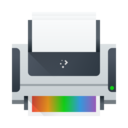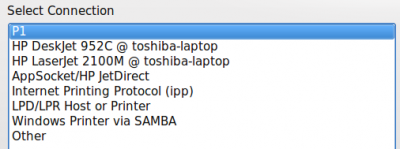System Settings/Printers/it: Difference between revisions
Created page with '{{Note|Le stampanti USB collegate direttamente al computer probabilmente saranno automaticamente riconosciute ed installate da un piccolo strumento KDE che si occupa della config...' |
Created page with 'Quando una stampante non è collegata direttamente al tuo computer con un cavo USB, avrai bisogno di utilizzare l'utilità '''Configurazione stampante''' per aggiungere la stampa...' |
||
| Line 20: | Line 20: | ||
[[Image:Printerapplet.png|center]] | [[Image:Printerapplet.png|center]] | ||
Quando una stampante non è collegata direttamente al tuo computer con un cavo USB, avrai bisogno di utilizzare l'utilità '''Configurazione stampante''' per aggiungere la stampante, per esempio quando un altro computer condivide una stampante o vuoi collegarti direttamente a una stampante che è in rete con un server di stampa. | |||
===Example=== | ===Example=== | ||
Revision as of 17:47, 11 September 2010
Printer Configuration
 |
Utilizza questo strumento per collegare il tuo computer ad una stampante e per impostare il necessario |
Elenco delle caratteristiche
- Aggiungere una stampante al tuo computer;
- dare ad ogni stampante un nome che aiuti ad identificarla;
- eseguire prove di stampa e fare manutenzione;
- rimuovere una stampante.

Quando una stampante non è collegata direttamente al tuo computer con un cavo USB, avrai bisogno di utilizzare l'utilità Configurazione stampante per aggiungere la stampante, per esempio quando un altro computer condivide una stampante o vuoi collegarti direttamente a una stampante che è in rete con un server di stampa.
Example
Follow these example steps to add a network connected printer to your computer. First, gather your printer information before you begin (make, model, IP number, etc).
Getting to the program is a sequence of straightforward steps.
- KDE
- Once you get to the tool, click the button to add a printer (Find and click the button between steps.)
- Your computer will search your local area network for printers that have been shared on other computers or are directly attached to the network.
In this example, I have an HP Laserjet 2100M which is connected directly to my network using a small print server on the printer.
The next illustration also shows that I have another computer sharing two printers on a Toshiba laptop. If I wanted to use either of them, that other computer would need to be on for the printer to work. Remote printers work best if directly connected to the network or are connected to a dedicated print server computer.

- I choose which is the choice for my HP/printserver.

- I enter the IP address number in the Host blank (Currently, the Printer Configuration tool does not identify what that number is, so you will need to ask your network administrator what the IP address is).
- Choose the manufacturer (Mine is HP)
- Choose the model (HP has many)
- Choose the recommended Driver unless you have a reason to do otherwise.
- Give the printer a useful name since "printer" may not be good enough.
- Give a description including the physical location if not in your own room.
- The "Location" defaults to your computer's name in case you decide to share it later. Sharing is one of the options of the printer configuration tool.
On the configuration screen, you will now see a new "Local Printer" because the printer is "attached" to your computer. If you have more than one printer, you should be sure to thoughtfully select one as the default. You might not want to set the big high speed departmental printer/copier in the department manager's office as your default if you have a small printer hooked directly to your computer.


